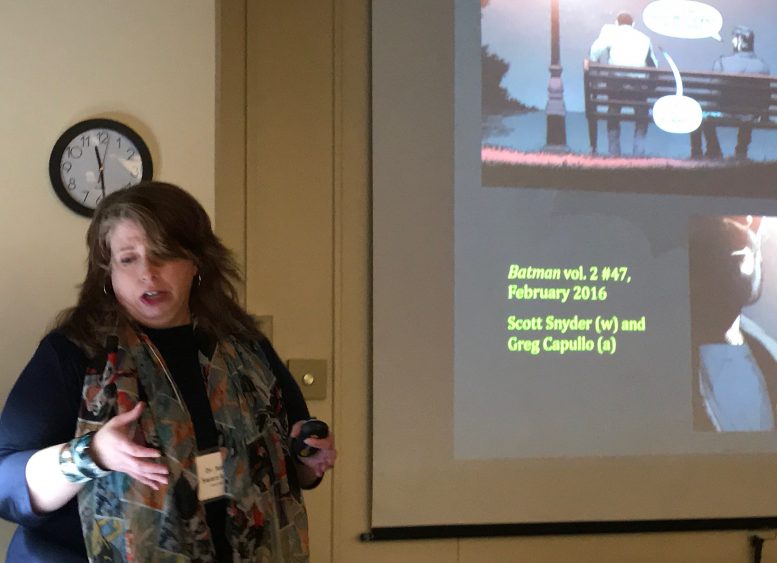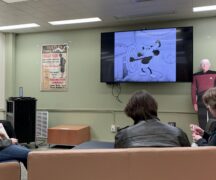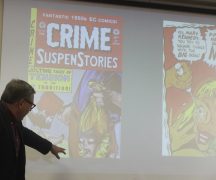By DAVID DUPONT
BG Independent News
In his 80 years as a super hero, Batman has captured the hearts of fans. Not just a fling, fans’ love of the Caped Crusader is a long standing affair.
The arrival of about 300 scholars and Caped Crusader devotees at Bowling Green State University this weekend for the Batman in Popular Culture conference is testament to that.
Tim Young, who hosts the podcast “To the Batpoles” with his brother, came from Tokyo to attend.
Like others at the conference, he had his personal Batman story. Young, who teaches English, and his brother Paul, who teaches film studies at Dartmouth College, are devotees of the 1960s TV series. They watched it in reruns as kids in the 1970s. They played Batman. They collected Batman action figures. They created a Batmobile from a cardboard refrigerator crate.
“It changed our lives,” Young said. That obsession helped shape their adult preoccupations. Their podcast, which they call “a research project into Batman ’66,” delves deeply into the arcana of the childhood favorite.
They study scripts from the initial treatment to the final script and how it appeared to viewers across the nation.
At BGSU he was surrounded by folks who shared his passion.
Matthew Donahue, one of the Popular Culture faculty members who organized the conference, said the event drew presenters and attendees from around the globe, including Germany, India, and England, as well as from across the United States.
The 85 presenters were there to discuss “all things Batman, everything you can imagine,” Donahue said.
That included Batman in religion, politics, and philosophy, including a panel on “Batman and Structural Supervillains: Patriarchy, Capitalism, Surveillance and Imperialism in Batman’s World.”
The character’s longevity has a lot to do with his appeal, Donahue said. “There’s a Batman for everybody because there’s been so many iterations of Batman over the decades.”
The Caped Crusader is “a super hero anybody can be.”
He is Bruce Wayne and doesn’t have super powers. Instead he uses his brain, brawn and expertise with technology to fight crime. “So in that regard Batman relates to folks.”
Charles Coletta, also an instructor in Popular Culture, said when he and Donahue started talking about the conference he wasn’t sure there would be enough interest to draw people to BGSU.
“Apparently there is,” he said.
“It shows you how rich the character is,” he said. Given all the iterations of the super hero,“there’s a Batman for everybody,” he said.
“People look at it as kids stuff, but people take it seriously. People just love this character.”
That may be true, but Batman himself has been unlucky in love.
That was the theme of Friday’s keynote address “Holy Bat Heartbreak: The Long Dark Knight of the Soul” by Jenny Swartz-Levine, dean of Lake Erie College in Pennsylvania.
Bruce Wayne, she said, has had “a complicated love life since 1939” when his first love interest, Julie Madison, appears. “The wealthiest man in Gotham is also the loneliest due to fractured relationships and perpetual heartbreak. … Bruce keeps finding love only to be betrayed by it.”
That pattern continues in the latest storylines.
Swartz-Levine warned those who hadn’t read the new issue “The Wedding” that she was going to spoil the ending of Batman’s affair with Catwoman.
Time and again, his love of Gotham proves stronger than his romantic love.
The women come in many types, Swartz-Levine said. They are social workers, socialites, and sociopaths.
They include Silver St. Cloud, who in one story line also carries on with Elmer Fudd, who is depicted as a hitman who wants to go straight. Yes, it’s complicated. Bugs the Bunny even gets framed for a murder.
The basic question seems to be whether a happy Bruce Wayne can function as Batman? Or is the misery and angst essential to the hero?
That Batman will never find love is burned into the character’s DNA.
Swartz-Levine said one editor defined the parameters of the story as: “Batman does not fly in space. Batman does not kill. Batman does not have a love life, poor bastard.”





